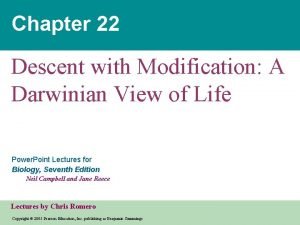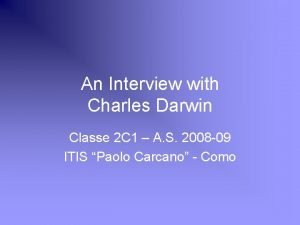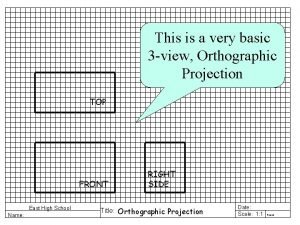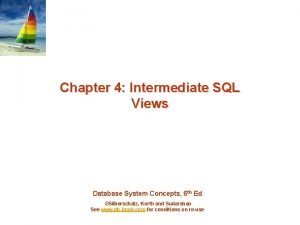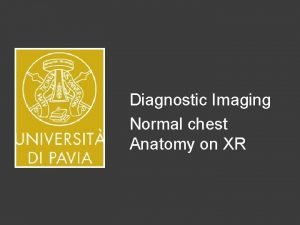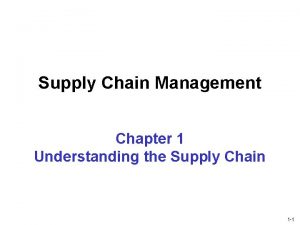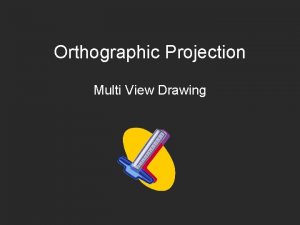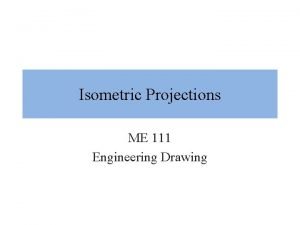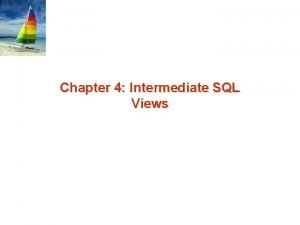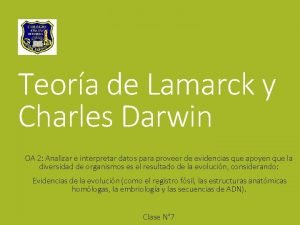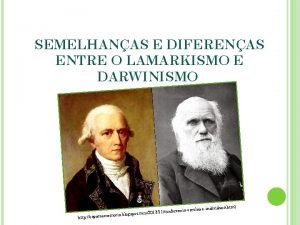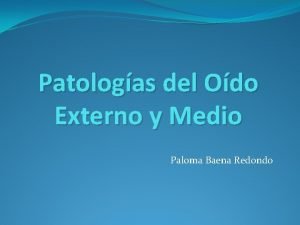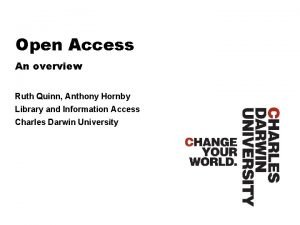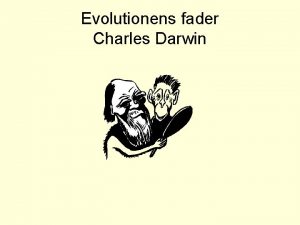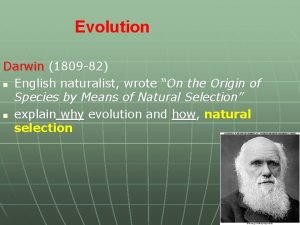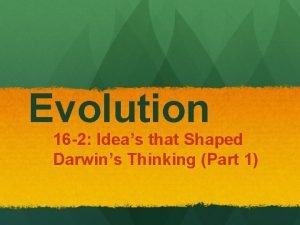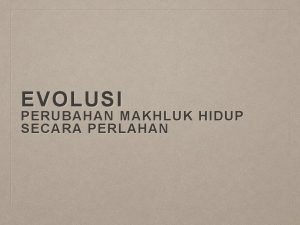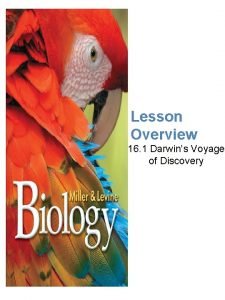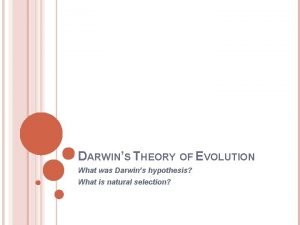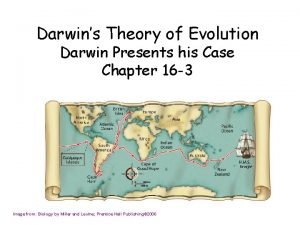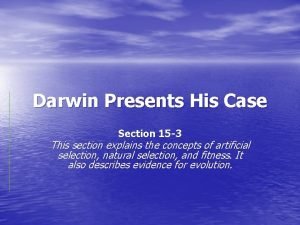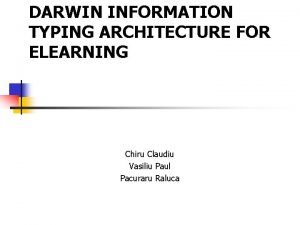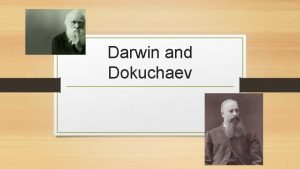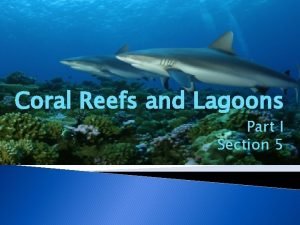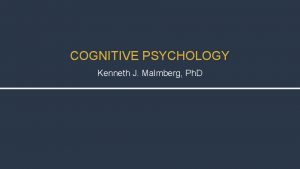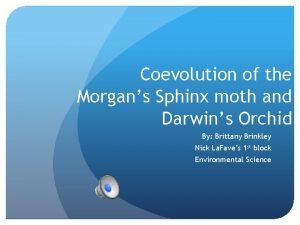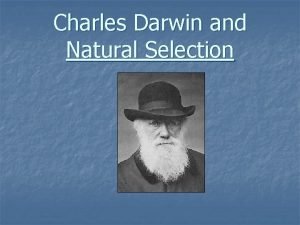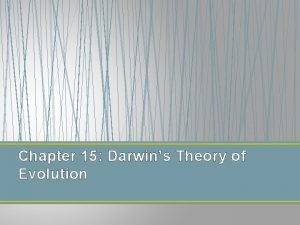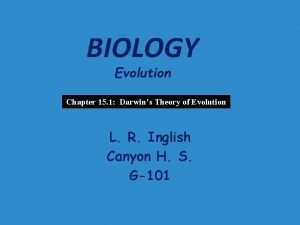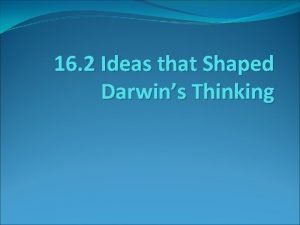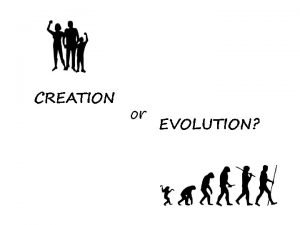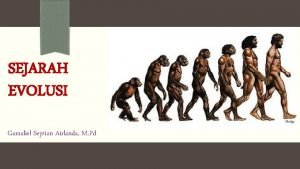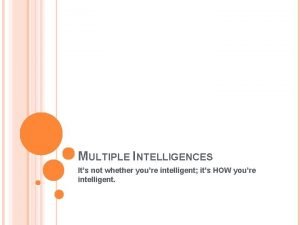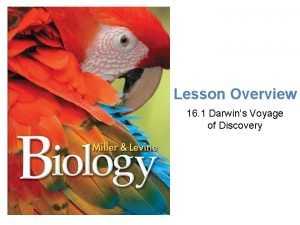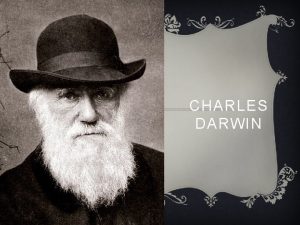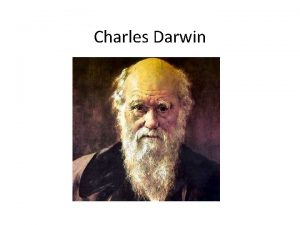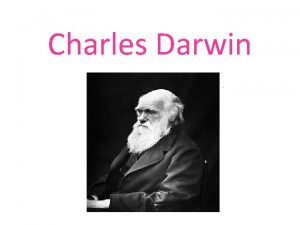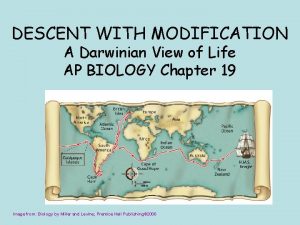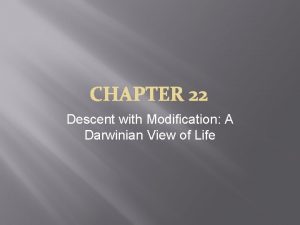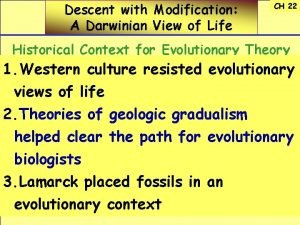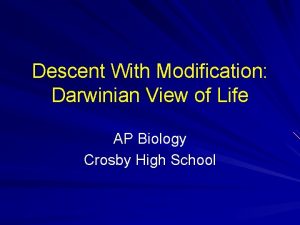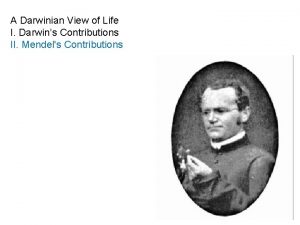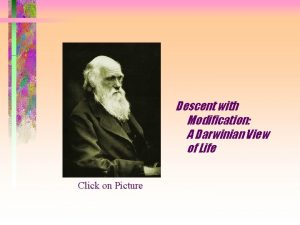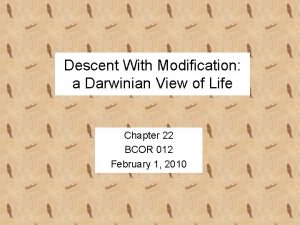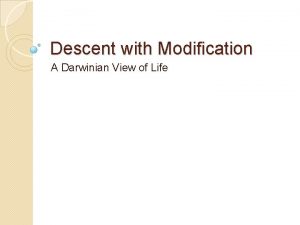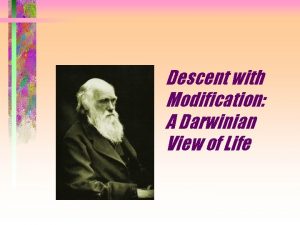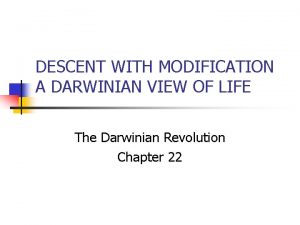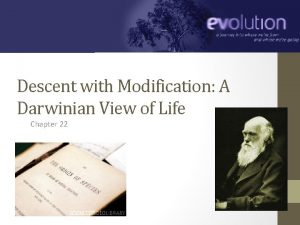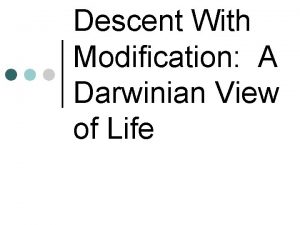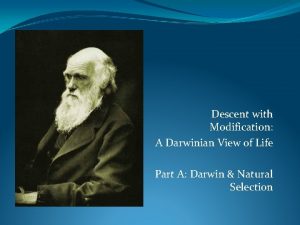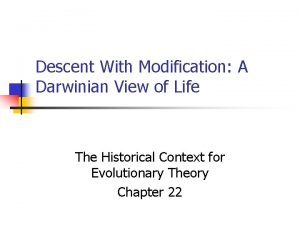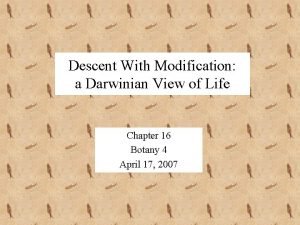A Darwinian View of Life I Overview Darwin




















































- Slides: 52

A Darwinian View of Life I. Overview - Darwin (1859) Origin of Species - Mendel (1865) Experiments in Plant Hybridization

II. Darwin’s Contributions A. Overview 1. Life - Born Feb 12, 1809 - Graduated Cambridge, intending to join the clergy - 1831 -36, Naturalist on H. M. S. Beagle - 1859: The Origin of Species - Died April 19, 1882, interred in Westminster Abbey

II. Darwin’s Contributions A. Overview 1. Life 2. The Origin of Species (1859)

II. Darwin’s Contributions A. Overview 1. Life 2. The Origin of Species (1859) a. “One Long Argument” - observations leading to the conclusions that: - life changes through time - species descend from shared ancestors

II. Darwin’s Contributions A. Overview 1. Life 2. The Origin of Species (1859) a. “One Long Argument” b. Mechanism explaining HOW evolution occurs - Natural Selection c. Dilemmas – challenges and apparent inconsistencies

B. Argument: Evidence for Evolution by Common Descent 1. Geology a. James Hutton (1726 -1797) - observed Hadrian’s Wall, but by the Roman Emperor Hadrian in 122 A. D. 1600 years old, but no sign of erosion. How much older must highly worn and eroded granite outcrops be?

B. Argument: Evidence for Evolution by Common Descent 1. Geology a. James Hutton (1726 -1797) - observed the White Cliffs of Dover – huge coccolith deposits. If sedimentation was slow and steady as it is today (‘uniformitarianism’), how long would it take to create such a deposit?

B. Argument: Evidence for Evolution by Common Descent 1. Geology a. James Hutton (1726 -1797) - Observed and interpreted the unconformity at Siccar Point

Process: 1. Initial depositional cycle

Process: 2. uplift (time)

Process: 3. erosion (time)

Process: 4. second depositional cycle (time)

B. Argument: Evidence for Evolution by Common Descent 1. Geology a. James Hutton (1726 -1797) - the rock cycles, so the earth has “no vestige of a beginning, no prospect of an end. ” THE EARTH IS REALLY OLD

B. Argument: Evidence for Evolution by Common Descent 1. Geology a. James Hutton (1726 -1797) b. Charles Lyell (1797 -1875) - Principles of Geology (1831 -33) - uniformitarianism - Darwin’s friend

B. Argument: Evidence for Evolution by Common Descent 1. Geology 2. Paleontology a. New types of organisms are added through the fossil record recent Mammals Birds Reptiles Amphibians Jawed fishes past Jawless fishes

2. Paleontology a. New types of organisms are added through the fossil record b. Within a lineage, there are progressive changes through time. The fossils in recent strata are more similar to existing species than fossils in older (deeper) strata.

B. Argument: Evidence for Evolution by Common Descent 1. Geology 2. Paleontology 3. Comparative Anatomy a. Homologous Structures Same structure, but different uses in different environments (correlated pattern) “Limitation of design”

3. Comparative Anatomy a. Homologous Structures b. Analogous Structures Different structures, but same uses in the same environment. (again, a correlation between anatomy and environment)

3. Comparative Anatomy a. Homologous Structures b. Analogous Structures c. Vestigial Structures

3. Comparative Anatomy a. Homologous Structures b. Analogous Structures c. Vestigial Structures

3. Comparative Anatomy a. Homologous Structures b. Analogous Structures c. Vestigial Structures d. Embryology Whale embryo w/leg buds photo Haeckel (after Darwin)

B. Argument: Evidence for Evolution by Common Descent 1. Geology 2. Paleontology 3. Comparative Anatomy 4. Biogeography a. Convergent Communities In similar environments, there are organisms that fill similar ecological roles – and they are morphologically similar (in an analogous, not homologous, manner). Correlated patterns

B. Argument: Evidence for Evolution by Common Descent 4. Biogeography a. Convergent Communities b. Island Communities

Voyage of the Beagle – Darwin (1845) "The natural history of these islands is eminently curious, and well deserves attention. Most of the organic productions are aboriginal creations, found nowhere else; Flightless Cormorant

“…there is even a difference between the inhabitants of the different islands; yet all show a marked relationship with those of America, though separated from that continent by an open space of ocean, between 500 and 600 miles in width. ” Green Iguana – Central and South America

“…The archipelago is a little world within itself, or rather a satellite attached to America, whence it has derived a few stray colonists, and has received the general character of its indigenous productions. Considering the small size of the islands, we feel the more astonished at the number of their aboriginal beings, and at their confined range. ” Galapagos Land Iguana, pallid species, only on Santa Fe island.

“… Seeing every height crowned with its crater, and the boundaries of most of the lava streams still distinct, we are led to believe that within a period geologically recent the unbroken ocean was here spread out. ”

“…Hence, both in space and time, we seem to be brought somewhat near to that great fact -- that mystery of mysteries -- the first appearance of new beings on this earth. ” The Voyage of the Beagle – Charles Darwin













B. Argument: Evidence for Evolution by Common Descent 4. Biogeography a. Convergent Communities b. Island Communities - Uniqueness correlates with degree of isolation - Dominated by dispersive forms

B. Argument: Evidence for Evolution by Common Descent 4. Biogeography a. Convergent Communities b. Island Communities - Uniqueness correlates with degree of isolation - Dominated by dispersive forms - Variation among islands

- Finches

"Seeing this gradation and diversity of structure in one small, intimately related group of birds, one might really fancy that from an original paucity of birds in this archipelago, one species had been taken and modified for different ends. "

B. Argument: Evidence for Evolution by Common Descent 4. Biogeography a. Convergent Communities b. Island Communities - Uniqueness correlates with degree of isolation - Dominated by dispersive forms - Variation among islands The fact that islands are populated by dispersive forms suggests that they came from populations on the mainland. However, the species on the islands are different from the mainland species. So, if the species originally came from the mainland, they must have changed through time to become the species we see today.

- Mockingbirds

- Mockingbirds Darwin classified four varieties of one species: One species

- Mockingbirds John Gould, the premiere ornithologist of the day, classified these as four species:

- Mockingbirds Darwin began to think… could the variation WITHIN species eventually lead to variation BETWEEN species? Could organisms in a species become so different that they become different species?

B. Argument: Evidence for Evolution by Common Descent 1. Geology 2. Paleontology 3. Comparative Anatomy 4. Biogeography 5. Argument For Evolution by Common Descent as Historical Fact Premise 1: Species that are alive today are different from those that have lived previously. Premise 2: Spontaneous Generation is refuted, so organisms only come from other organisms. Conclusion 1: Thus, the organisms alive today must have come from those pre-existing, yet different, species. Conclusion 2: There must have been change through time (evolution). Conclusion 3: The fossil record, vestigial organs, and homologies are all suggestive of descent from common ancestors.


Darwin's Mockingbirds
 Descent with modification: a darwinian view of life
Descent with modification: a darwinian view of life The darwin
The darwin The orthographic view drawn directly above the front view.
The orthographic view drawn directly above the front view. What is a revolved section view? a revolved section view:
What is a revolved section view? a revolved section view: When should a revolved section be used?
When should a revolved section be used? Symbol of cutting plane line
Symbol of cutting plane line Worms eye view vs low angle
Worms eye view vs low angle Name
Name Simple isometric drawing
Simple isometric drawing For the view create view instructor_info as
For the view create view instructor_info as Simple view and complex view
Simple view and complex view Simple view and complex view
Simple view and complex view Simple view and complex view
Simple view and complex view Mvc html partial
Mvc html partial Anatomy chest x ray
Anatomy chest x ray Scm cycle view
Scm cycle view User view and system view in os
User view and system view in os Integration view of ethics
Integration view of ethics Multiview orthographic projection
Multiview orthographic projection Front view top view
Front view top view Isometric view of hexagon
Isometric view of hexagon For the view create view instructor_info as
For the view create view instructor_info as Lamarck vs darwin
Lamarck vs darwin Cuadro comparativo de darwin y lamarck
Cuadro comparativo de darwin y lamarck Semelhanças entre darwinismo e lamarckismo
Semelhanças entre darwinismo e lamarckismo Atresia aural
Atresia aural Hornby cdu
Hornby cdu Section 15-2 ideas that shaped answer key
Section 15-2 ideas that shaped answer key Evolutionens fader
Evolutionens fader Darwin and evolution
Darwin and evolution 16.2 ideas that shaped darwin's thinking
16.2 ideas that shaped darwin's thinking Perkawinan antara dua ekor tikus yang dipotong ekornya
Perkawinan antara dua ekor tikus yang dipotong ekornya Lesson 1 darwins voyage of discovery
Lesson 1 darwins voyage of discovery Darwin's hypothesis
Darwin's hypothesis 16 3 darwin presents his case answer key
16 3 darwin presents his case answer key Strengths and weaknesses of evolutionary theory page 386
Strengths and weaknesses of evolutionary theory page 386 Section 15-3 darwin presents his case answers
Section 15-3 darwin presents his case answers Darwin information typing architecture
Darwin information typing architecture Hydraulic topsoil darwin
Hydraulic topsoil darwin How is an atoll formed
How is an atoll formed Kenneth j malmberg
Kenneth j malmberg Morgan's sphinx moth and darwin's orchid
Morgan's sphinx moth and darwin's orchid Whos darwin
Whos darwin Chapter 17 darwin's theory of evolution
Chapter 17 darwin's theory of evolution Chapter 15 darwin's theory of evolution section review 15-1
Chapter 15 darwin's theory of evolution section review 15-1 Chapter 15 darwin's theory of evolution section review 15-1
Chapter 15 darwin's theory of evolution section review 15-1 Section 15-2 ideas that shaped darwin's thinking
Section 15-2 ideas that shaped darwin's thinking Where was charles darwin born
Where was charles darwin born Explain the theory of evolution
Explain the theory of evolution Where was charles darwin born
Where was charles darwin born Teori evolusi pasca darwin
Teori evolusi pasca darwin Famous person with verbal linguistic intelligence
Famous person with verbal linguistic intelligence Darwin's epic journey
Darwin's epic journey
